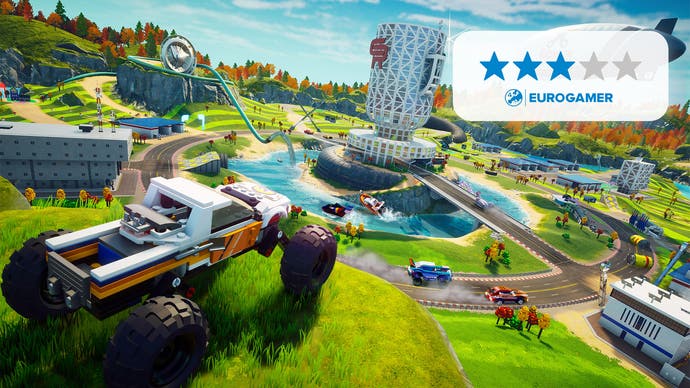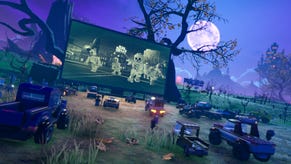Lego 2K Drive review - a plastic dream with too much grind
Brick and motor.
"Lego 2K Drive" sounds like a charity event: a two-kilometre fun run perhaps, sponsored by, or with the goal of donating, Lego. It is, in fact, a video game - an open-world racer, richly encrusted with bricks - but its mission is no less in the spirit of giving. The aim of any Lego video game, surely, is to provide us with something to do with our completed creations. In real life, the joy (or at least the contended, driven quiet) is in the building. After you have plugged it all together, and you're left with your Death Star, your Batmobile, or whatever, they wind up trophied on the shelf, to be lightly trimmed with dust. Not so in Lego 2K Drive, where life is bright, pre-assembled, and anything but still. If only it were more than the sum of its parts.
What are those parts, exactly? For 2K Drive, developer Visual Concepts has looked to the likes of Forza Horizon, Mario Kart, and Crash Team Racing. This is a wise decision, kitbashing with the choicest of kits, but it invites harsh contrast. The weapons that you collect during races, for example, lack the wit of those in Mario Kart. Take the spiderweb, which fastens onto foes and causes them to come unstuck. It's a spin on the Blooper, the wide-eyed squid that squirts ink on your opponent's screen; but it lacks the slippery humour, the slight taunting pause before the Blooper gets down to his murky work, letting your enemy know that they have been suckered just before it happens. Instead, the web is spring-loaded and instant, cocooning them in bad handling until they hop it off.
Then again, not every comparison is a damning one. The structure of the adventure here may crib lovingly from Forza Horizon, with its stretches of open country and its heavy strewing of activities, but I wasn't in the least bit surprised to learn that the inhabitants of Bricklandia, as it's called, are actually less plastic than the staff at the Horizon Festival. I adore that series, but I always shudder at the assault of dead positivity, all halogen smiles and stale encouragement. What a relief, playing Lego 2K Drive, to be sped into the tutelage of Clutch Racington, a stubbled grin in a helmet, hands clipped to the wheel at ten and two. We hear, via a news report, that Clutch is an "Ex-bigshot driver, now charismatic mentor who trains rookie racers. Which is lucky for you and convenient for the story!"
As was the case with The Lego Movie, in which the standard blocks of narrative were tipped out and playfully inspected, this irreverence starts as a tonic, gradually loses its fizz, and fortunately gives way to a scattering of good gags. When the game's villain, Shadow Z, describes you as a "no-name nobody who's suddenly a threat to me for no apparent reason!," you know you're in ironic hands. (Lovers of Crash Team Racing, however, may point out that such knowingness drains away some of the fun. When that game's villain, Nitrous Oxide, threatened to "turn your entire globe into a concrete parking lot and make you my slaves," you knew he was for real, but you also knew he was a gasbag, and the laughter leaked through.) I couldn't care less about whooping Shadow Z, but I relished the sight of a horse driving a car, almost as much as that of a pair of monkeys running a garage.
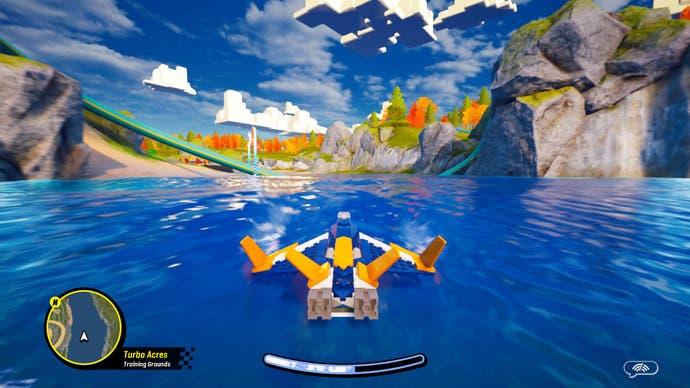
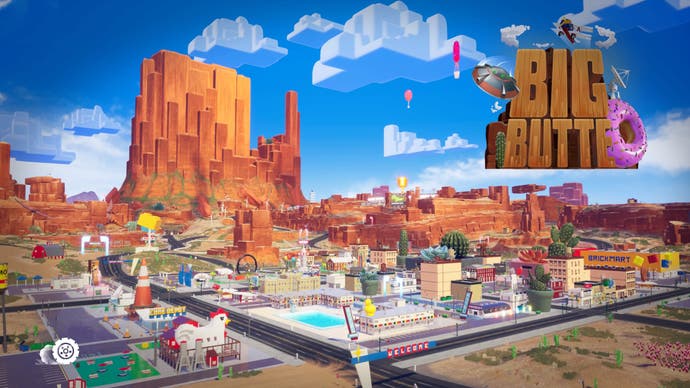
At any rate, who really needs a plot when you have a procession of Legoid biomes to burn through? We begin in Turbo Acres, a clean green raceway where Clutch inducts you into the rhythms of the action. These include quests, which have you locating lost items, shearing weeds in a power mower, or crunching through waves of aliens, skeletons, and what have you. Police chases, where you hound suspects with missiles until they burst and flake down to a bare chassis. And point-to-point time trials, a knuckle-chewing challenge, if you desire anything north of a bronze medal. None of these diversions are as compelling as pure races - victory in which will net you flags, the better to unlock the championship gauntlets and, crucially, more of Bricklandia.
We have Prospecto Valley, a rocky sweep of pickaxes and glinting nuggets, bringing new and rubbery meaning to the phrase "gold rush." Hauntsborough, meanwhile, is a sprawl of mansions and misted hills, riddled with arachnids. My personal favourite is Big Butte County, with its see-sawing boulders. It calls to mind the backdrops of Wile E. Coyote and the Road Runner; in particular, the later designs, by Maurice Noble, in episodes such as "Zoom and Bored," where the scenery - pink and parched shapes, roughed out squiggles of rock - took on an abstract style. As a rule, anything that even vaguely evokes the work of Looney Tunes is worth one's time, and Visual Concepts does well to channel the allure of Lego: the way it pulls in such a disparate array of sources and makes them click. In no other world can you imagine these vistas not clashing. How else could they be united, if not by the notion that each can be bought in a bucket and snapped together?


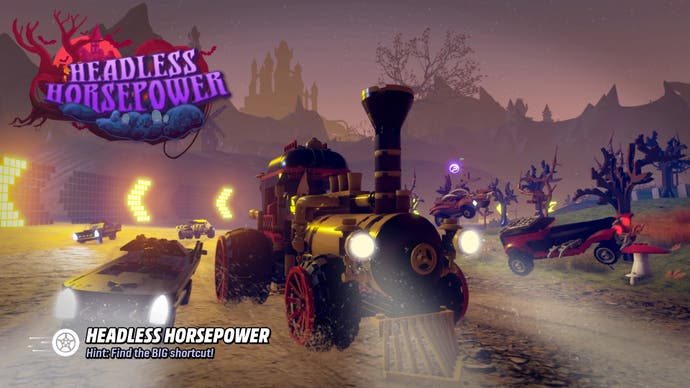

The point of all these diversions is the upward tick of XP, which turns into a slog later on, as you're gated off and forced to grind it out. (A grind unalleviated by the in-game shop; after finishing the career mode, I only had enough cash for four vehicles, and there is no option to buy XP.) It feels as though Visual Concepts had run out of road and defaulted to busywork. The handling is heavy and slurred with drifts, in a way that recalls Hotshot Racing; but that game was stripped-down and tuned to a tight format - no open world, just a string of modes. You never had the space for any tedium to seep in. Here I spent a slew of hours haring around, trying to reach an arbitrary level, and the fun had thinned out like fumes. Talk about zoom and bored.
If you are in a creative mood, you can cobble together fresh vehicles. My garage harbours a grim monument to my own aborted efforts: a barren plank of grey, capped with a couple of dark bars of nothing, sixteen pieces in total. And there it will lurk, "New Vehicle 00," unfit for submission to 2K's approval process. Still, the customisation is of dizzying depth, and if you thrill to the prospect of sitting and tinkering, have at it. One reason I couldn't be bothered is that I was too daunted by the machines that you win, already built. Check out the Hamburghini Royale, all 227 pieces artfully pressed into service as beef and bun, with glimpses of lettuce and yellow cheese - a tooth-cracking meal on wheels.

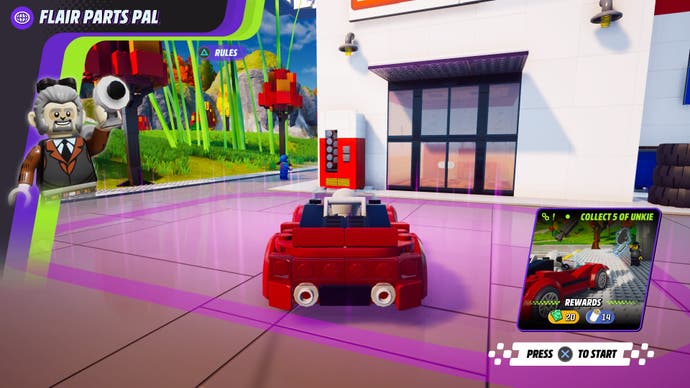
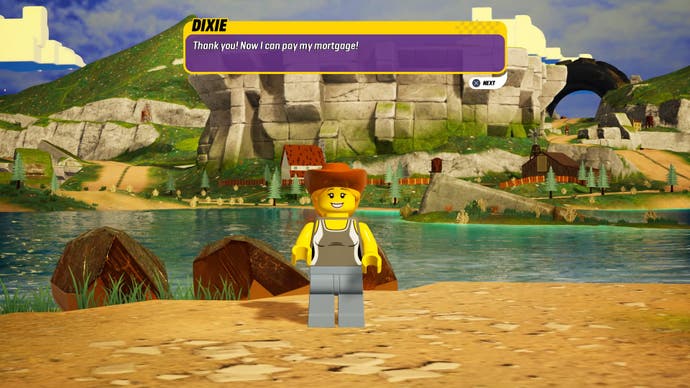

If only Lego 2K Drive offered more food for thought. Visual Concepts has a neat kinetic humour; watch as your car morphs - chikka-chikka-chikka - into different forms for road, dirt, and water, as if re-dreamt on the fly. But it isn't backed by mechanics as deep or compelling as they need to be. The races have a rubber-banded difficulty, designed to keep things tense, but no call feels truly close when it's settled ahead of time.
Really, Lego 2K Drive was prefigured in 2019, with the Lego Speed Champions DLC for Forza Horizon 4, where Playground Games plugged its wondrous driving into a surfeit of visual jokes. The best of which was how well the British landscape, with its greebled turf and boxy clouds, responded to its toyish transformation - all those skittering dry stone walls you had ploughed through seemed right at home in Legofied form. From there, I guess, the idea grew and grew, but I can't help wondering if it should have stayed put.
